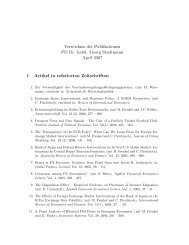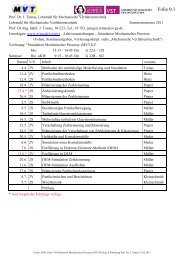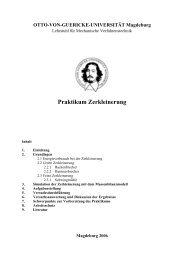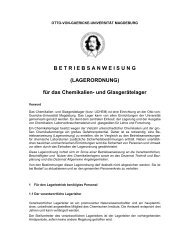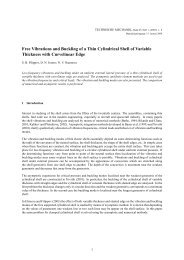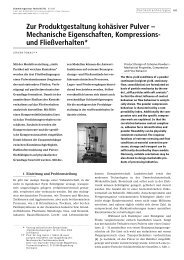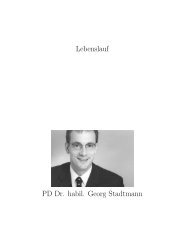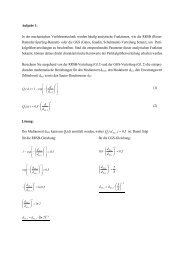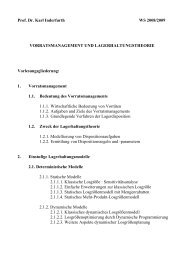22J. TomasThus, the elastic–plastic force–displacement models introduced by Schubert etal. [57], Eq. (44), and Thornton [60] Eq. (47)( )F N =π⋅p f ⋅r 1,2 ⋅ h K −hK,f / 3(47)should be supplemented here with a complete attractive force contribution due tocontact flattening described before. Taking into account Eqs. (41), (42) and (44),the particle contact force equilibrium between attraction (-) and elastic plus, simultaneously,plastic repulsion (+) is given by ( r * Krepresents the coordinate <strong>of</strong>annular elastic contact area):2 2H0 VdWπK N fπK,plF = 0 =−F − p ⋅ ⋅r − F + p ⋅ ⋅rrKK,pl* * *el K K K+ 2 ⋅π⋅ p ( r ) ⋅r drr3/2(48)222 2 2⋅π⋅ pmax ⋅r rK K,pl FN + F H0+ pVdW ⋅π ⋅ rK = pf ⋅π ⋅ rK,pl+ ⋅ 1− 3 (49)r K At the yield point r K = r K,pl the maximum contact pressure reaches the yieldstrength p el = p f .222 2 2⋅π⋅rK pf FN + F H0+ pVdW ⋅π ⋅ rK = pf ⋅ π ⋅ rK,pl+ ⋅3 (50) pmax Because <strong>of</strong> plastic yielding, a pressure higher than p f is absolutely not possibleand thus, the fictitious contact pressure p max is eliminated by Eq. (1):2 22 2 2⋅π⋅r r K K,plFN + FH0 + p VdW⋅π ⋅ rK = pf ⋅ π ⋅ rK,pl + ⋅ 1−(51)32 r K Finally, the contact force equilibrium2r2K,pl+ + ⋅ = π ⋅ ⋅ ⋅ 2+ 1⋅N H0 VdW K f K 3 3 2 rKF F p A p rand the total contact area A K are obtained: A= p ⋅A⋅ 2+ 1⋅f K 3 3 AplK(52)
<strong>Mechanics</strong> <strong>of</strong> <strong>nanoparticle</strong> <strong>adhesion</strong> — A <strong>continuum</strong> <strong>approach</strong> 23AK=FN+ FH0 A2 1 pl pf⋅ + ⋅ −3 3pAK VdW(53)Next, the elastic–plastic contact area coefficient κ A is introduced. This dimensionlesscoefficient represents the ratio <strong>of</strong> plastic particle contact deformation areaA pl to total contact deformation area AK = Apl + A and includes a certain elasticeldisplacement:κ 2 1 plA= + ⋅ A 3 3 A(54)The solely elastic contact deformation A pl = 0, κ A = 2/3, has only minor relevancefor cohesive powders in loading (Fig. 2), but for the complete plastic contactdeformation (A pl = A K ) the coefficient κ A = 1 is obtained.From Eqs. (43), (53) and (54) the sum <strong>of</strong> contact normal forces is obtained as:K( )2N+H0= ⋅K⋅ f⋅A−pF F π r p κ κ (55)From Eq. (5) the transition radius <strong>of</strong> elastic-plastic model r K,f,el-pl (index el-pl)and from Eq. (6) the particle center <strong>approach</strong> <strong>of</strong> the two particles h K,f,el-pl are calculatedas:h( )3⋅π ⋅r⋅ p ⋅ κ −κ1,2 f A p=K,f,el−pl *r2⋅E( ) 22 29⋅π ⋅r⋅ p ⋅ κ −κ1,2 f A pK,f,el−=pl* 24⋅E(56)(57)Checking this model, Eq. (56), with pure elastic contact deformation, i.e., κ p →0 and κ A = 2/3, the elastic transition radius r K,f , Eq. (29), is also obtained. For example,nanodisperse titania particles (d 50,3 = 610 nm is the median diameter onmass basis (index 3), E = 50 kN/mm 2 modulus <strong>of</strong> elasticity, ν = 0.28 Poisson ratio,p f = 400 N/mm 2 micro-yield strength, κ A ≈ 5/6 contact area ratio, κ p = 0.44plastic repulsion coefficient) a contact radius <strong>of</strong> r K,f,el-pl = 2.1 nm and, from Eq.(57), a homeopathic center <strong>approach</strong> <strong>of</strong> only h K,f,el-pl = 0.03 nm are obtained. Thisis a very small indentation calculated, in principle, by means <strong>of</strong> a <strong>continuum</strong> <strong>approach</strong>.The contact deformation is equivalent to a microscopic force F N = 2.1 nNor to a small macroscopic pressure level <strong>of</strong> about σ = 1.4 kPa (porosity ε = 0.8) inpowder handling and processing.



